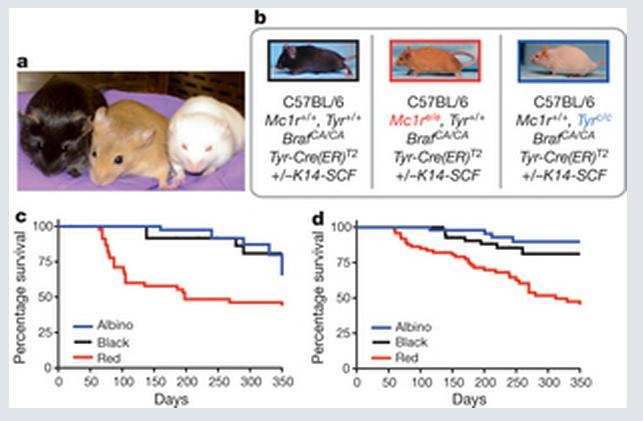Red-haired mice can get melanoma without UV
An ultraviolet-radiation-independent pathway to melanoma carcinogenesis in the red hair/fair skin background
Devarati Mitra, Xi Luo, Ann Morgan, Jin Wang, Mai P. Hoang, Jennifer Lo, Candace R. Guerrero, Jochen K. Lennerz, Martin C. Mihm, Jennifer A. Wargo, Kathleen C. Robinson, Suprabha P. Devi, Jillian C. Vanover, John A. D’Orazio, Martin McMahon, Marcus W. Bosenberg, Kevin M. Haigis, Daniel A. Haber, Yinsheng Wang & David E. Fisher
AffiliationsContributionsCorresponding author
Nature 491, 449–453 (15 November 2012) doi:10.1038/nature11624
Received 27 February 2012 Accepted 27 September 2012 Published online 31 October 2012
People with pale skin, red hair, freckles and an inability to tan—the ‘red hair/fair skin’ phenotype—are at highest risk of developing melanoma, compared to all other pigmentation types1. Genetically, this phenotype is frequently the product of inactivating polymorphisms in the melanocortin 1 receptor (MC1R) gene. MC1R encodes a cyclic AMP-stimulating G-protein-coupled receptor that controls pigment production. Minimal receptor activity, as in red hair/fair skin polymorphisms, produces the red/yellow pheomelanin pigment, whereas increasing MC1R activity stimulates the production of black/brown eumelanin2. Pheomelanin has weak shielding capacity against ultraviolet radiation relative to eumelanin, and has been shown to amplify ultraviolet-A-induced reactive oxygen species3, 4, 5. Several observations, however, complicate the assumption that melanoma risk is completely ultraviolet-radiation-dependent. For example, unlike non-melanoma skin cancers, melanoma is not restricted to sun-exposed skin and ultraviolet radiation signature mutations are infrequently oncogenic drivers6.
Although linkage of melanoma risk to ultraviolet radiation exposure is beyond doubt, ultraviolet-radiation-independent events are likely to have a significant role1, 7.
Here we introduce a conditional, melanocyte-targeted allele of the most common melanoma oncoprotein, BRAFV600E, into mice carrying an inactivating mutation in the Mc1r gene (these mice have a phenotype analogous to red hair/fair skin humans). We observed a high incidence of invasive melanomas without providing additional gene aberrations or ultraviolet radiation exposure. To investigate the mechanism of ultraviolet-radiation-independent carcinogenesis, we introduced an albino allele, which ablates all pigment production on the Mc1re/e background. Selective absence of pheomelanin synthesis was protective against melanoma development. In addition, normal Mc1re/e mouse skin was found to have significantly greater oxidative DNA and lipid damage than albino-Mc1re/e mouse skin. These data suggest that the pheomelanin pigment pathway produces ultraviolet-radiation-independent carcinogenic contributions to melanomagenesis by a mechanism of oxidative damage. Although protection from ultraviolet radiation remains important, additional strategies may be required for optimal melanoma prevention.
Free fuzzy image of this study from the web

